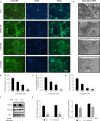Sotrastaurin, a PKC inhibitor, attenuates RANKL-induced bone resorption and attenuates osteochondral pathologies associated with the development of OA
- PMID: 32652826
- PMCID: PMC7412701
- DOI: 10.1111/jcmm.15404
Sotrastaurin, a PKC inhibitor, attenuates RANKL-induced bone resorption and attenuates osteochondral pathologies associated with the development of OA
Abstract
Osteoarthritis (OA) is a common degenerative disease that affects the musculoskeletal structure of the whole joint, which is characterized by progressive destruction of both articular cartilage and subchondral bone. Treatment of the bone pathologies, particularly osteoclast-mediated subchondral bone loss in the early stages of OA, could prevent subsequent cartilage degeneration and progression of OA. In the present study, the PKC inhibitor, Sotrastaurin, was found to inhibit RANKL-induced osteoclast formation in vitro in a dose- and time-dependent manner. In particular, SO exerted its anti-osteoclastic effect predominantly at the early stages of RANKL stimulation, suggesting inhibitory effects on precursor cell fusion. Using mature osteoclasts cultured on bovine bone discs, we showed that SO also exerts anti-resorptive effects on mature osteoclasts bone resorptive function. Mechanistically, SO attenuates the early activation of the p38, ERK and JNK signalling pathways, leeding to impaired induction of crucial osteoclast transcription factors c-Jun, c-Fos and NFATc1. We also showed that SO treatment significantly inhibited the phosphorylation of PKCδ and MARCKS, an upstream regulator of cathepsin K secretion. Finally, in animal studies, SO significantly alleviates the osteochondral pathologies of subchondral bone destruction as well as articular cartilage degeneration following DMM-induced OA, markedly improving OARSI scores. The reduced subchondral bone loss was associated with marked reductions in TRAP(+) osteoclasts in the subchondral bone tissue. Collectively, our data provide evidence for the protective effects of SO against OA by preventing aberrant subchondral bone and articular cartilage changes. Thus, SO demonstrates potential for further development as an alternative therapeutic option against OA.
Keywords: PKCδ; osteoclast; sotrastaurin; subchondral bone; therapeutics.
© The Authors. Journal of Cellular and Molecular Medicine published by Foundation for Cellular and Molecular Medicine and John Wiley & Sons Ltd.
Conflict of interest statement
The authors have no conflicts of interests to declare.
Figures






Similar articles
-
Farnesoid X receptor agonist attenuates subchondral bone osteoclast fusion and osteochondral pathologies of osteoarthritis via suppressing JNK1/2/NFATc1 pathway.FASEB J. 2022 Apr;36(4):e22243. doi: 10.1096/fj.202101717R. FASEB J. 2022. PMID: 35224782
-
Dihydroartemisinin attenuates osteoclast formation and bone resorption via inhibiting the NF‑κB, MAPK and NFATc1 signaling pathways and alleviates osteoarthritis.Int J Mol Med. 2022 Jan;49(1):4. doi: 10.3892/ijmm.2021.5059. Epub 2021 Nov 5. Int J Mol Med. 2022. PMID: 34738623 Free PMC article.
-
Osteoclasts are recruited to the subchondral bone in naturally occurring post-traumatic equine carpal osteoarthritis and may contribute to cartilage degradation.Osteoarthritis Cartilage. 2016 Mar;24(3):555-66. doi: 10.1016/j.joca.2015.10.008. Epub 2015 Oct 24. Osteoarthritis Cartilage. 2016. PMID: 26505663
-
Subchondral osteoclasts and osteoarthritis: new insights and potential therapeutic avenues.Acta Biochim Biophys Sin (Shanghai). 2024 Apr 25;56(4):499-512. doi: 10.3724/abbs.2024017. Acta Biochim Biophys Sin (Shanghai). 2024. PMID: 38439665 Free PMC article. Review.
-
Potential Role of Rebamipide in Osteoclast Differentiation and Mandibular Condylar Cartilage Homeostasis.Curr Rheumatol Rev. 2018 Apr 20;14(1):62-69. doi: 10.2174/1573397113666171017113441. Curr Rheumatol Rev. 2018. PMID: 29046162 Free PMC article. Review.
Cited by
-
TRPM2 promotes pancreatic cancer by PKC/MAPK pathway.Cell Death Dis. 2021 Jun 7;12(6):585. doi: 10.1038/s41419-021-03856-9. Cell Death Dis. 2021. PMID: 34099637 Free PMC article.
-
PRMT5 inhibition attenuates cartilage degradation by reducing MAPK and NF-κB signaling.Arthritis Res Ther. 2020 Sep 4;22(1):201. doi: 10.1186/s13075-020-02304-x. Arthritis Res Ther. 2020. PMID: 32887644 Free PMC article.
-
Multiomics analyses reveal high yield-related genes in the hypothalamic-pituitary-ovarian/liver axis of chicken.Poult Sci. 2024 Dec;103(12):104276. doi: 10.1016/j.psj.2024.104276. Epub 2024 Sep 2. Poult Sci. 2024. PMID: 39299017 Free PMC article.
-
Finding the Goldilocks Zone of Mechanical Loading: A Comprehensive Review of Mechanical Loading in the Prevention and Treatment of Knee Osteoarthritis.Bioengineering (Basel). 2024 Jan 24;11(2):110. doi: 10.3390/bioengineering11020110. Bioengineering (Basel). 2024. PMID: 38391596 Free PMC article. Review.
-
Osteoarthritis: Insights into Diagnosis, Pathophysiology, Therapeutic Avenues, and the Potential of Natural Extracts.Curr Issues Mol Biol. 2024 Apr 29;46(5):4063-4105. doi: 10.3390/cimb46050251. Curr Issues Mol Biol. 2024. PMID: 38785519 Free PMC article. Review.
References
-
- Gu Y‐T, Chen J, Meng Z‐L, et al. Research progress on osteoarthritis treatment mechanisms. Biomed Pharmacother. 2017;93:1246‐1252. - PubMed
-
- Cross M, Smith E, Hoy D, et al. The global burden of hip and knee osteoarthritis: estimates from the global burden of disease 2010 study. Ann Rheum Dis. 2014;73(7):1323‐1330. - PubMed
-
- Iijima H, Aoyama T, Ito A, et al. Effects of short‐term gentle treadmill walking on subchondral bone in a rat model of instability‐induced osteoarthritis. Osteoarthritis Cartilage. 2015;23(9):1563‐1574. - PubMed
-
- Rahmati M, Mobasheri A, Mozafari M. Inflammatory mediators in osteoarthritis: a critical review of the state‐of‐the‐art, current prospects, and future challenges. Bone. 2016;85:81‐90. - PubMed
-
- Iijima H, Aoyama T, Ito A, et al. Destabilization of the medial meniscus leads to subchondral bone defects and site‐specific cartilage degeneration in an experimental rat model. Osteoarthritis Cartilage. 2014;22(7):1036‐1043. - PubMed
Publication types
MeSH terms
Substances
LinkOut - more resources
Full Text Sources
Medical
Research Materials
Miscellaneous

